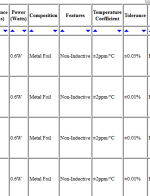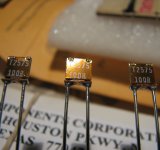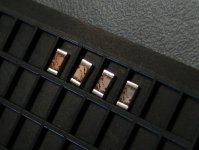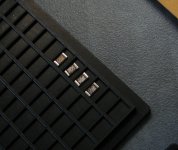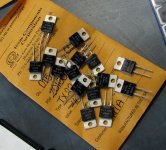Did anybody notice the comments in the latest Audio Precision newsletter about metal foil resistors having low frequency modulation distortion? They suggested that conventional metal films are better choices for audio. IMO, that should raise some high end eyebrows.
Now, my question is what's the test setup to reveal this, particularly if one doesn't have the $$ for an AP setup?
AP Powerpoint article
Now, my question is what's the test setup to reveal this, particularly if one doesn't have the $$ for an AP setup?
AP Powerpoint article
Attachments
it appears that Hofer is saying that some bulk metal foil don't perform proportionately as much better than some thin film just considering TCR
a guess would be that the extreme low TCR are obtained in part by balancing mechanical strain and TC of substrate and foil - so there is a more complicated thermo-mechanical effect that doesn't work to full benefit above fractional Hz and below kHz
but the foil still has as low TCR as any thin film as far as I know – so it shouldn't actually be worse than thin film – just not as much better as might be expected by the DC TCR ratios
it would be useful to know which “some bulk metal foil” are that show this – Z foil? - differ between chips, leaded, “naked”, fully encapsulated? as well as the numbers, plots
a guess would be that the extreme low TCR are obtained in part by balancing mechanical strain and TC of substrate and foil - so there is a more complicated thermo-mechanical effect that doesn't work to full benefit above fractional Hz and below kHz
but the foil still has as low TCR as any thin film as far as I know – so it shouldn't actually be worse than thin film – just not as much better as might be expected by the DC TCR ratios
it would be useful to know which “some bulk metal foil” are that show this – Z foil? - differ between chips, leaded, “naked”, fully encapsulated? as well as the numbers, plots
Did anybody notice the comments in the latest Audio Precision newsletter about metal foil resistors having low frequency modulation distortion? They suggested that conventional metal films are better choices for audio. IMO, that should raise some high end eyebrows.
Now, my question is what's the test setup to reveal this, particularly if one doesn't have the $$ for an AP setup?
AP Powerpoint article
You don't need an AP just ten of the same resistors and any analyzer. even a PC. This was covered in the Blowtorch thread a few years back.
specific examples... as in brand, types, styles, power ratings...
of course I'd also like to know at what % of rated power these problems showed up (vs. metal film for example).
there is only a couple brands. Vishay Precision Group aka VPG is the main one, texas components are an offshoot of VPG and manufacture small run (as low as single quantities) custom value foil parts where you can choose the exact resistance, TC, absolute tolerance as well as matching in pairs, quads etc. for a price ...
the best known part here on DIYA is the TX2575 'naked resistor'
below is also some of my ASMP naked zfoil SMD resistors.
and some TX220Z power resistors
the 'naked' parts are only available from texas components, not vishay. they came about due to audiophiles there is no objective reasoning and they arent naked anyway. it was thought that no dielectric may 'sound' more transparent ... I get them for the excellent tolerance, ability to buy matched, odd values to 0.0005% and because they are sexy
I also use thin film a lot; in fact those are pretty much all I use these days, those 2. lately i'm loving the vishay thin film soic8 resistor networks for input stages.
I believe there may be some other brands, but i'm not sure what they are.
most parts will be cheaper to buy from texas components than the VPG equivalent at digikey, who seem to have some OTT prices on some of the parts, like more than double the price
the best known part here on DIYA is the TX2575 'naked resistor'
below is also some of my ASMP naked zfoil SMD resistors.
and some TX220Z power resistors
the 'naked' parts are only available from texas components, not vishay. they came about due to audiophiles there is no objective reasoning and they arent naked anyway. it was thought that no dielectric may 'sound' more transparent ... I get them for the excellent tolerance, ability to buy matched, odd values to 0.0005% and because they are sexy
I also use thin film a lot; in fact those are pretty much all I use these days, those 2. lately i'm loving the vishay thin film soic8 resistor networks for input stages.
I believe there may be some other brands, but i'm not sure what they are.
most parts will be cheaper to buy from texas components than the VPG equivalent at digikey, who seem to have some OTT prices on some of the parts, like more than double the price
Attachments
Last edited:
If the foils had a high TC, which they typically don't, I could see a LF distortion issue, but it's not clear that's what they're talking about. Or, do they mean plain old IM distortion, but at low frequencies rather than the usual standards? Maybe I need to shoot 'em an email as I'm quite curious about this.
Simon,
Do you have any information as to the veracity of the claim made?
_-_-
Yes,
The lowest distortion resistor depends on not just the resistor construction, but also the AC level and frequency, any DC applied and of course the value of the resistor.
So what is the best 1K resistor for 2 volts AC at 50 Hz is probably not the best at 1kHz 100K 2 volts!
Of course what is interesting is some folks who prefer carbon composition and list their order of preference correctly rank them from highest distortion to lowest! The some folks correctly rank metal film types from the lowest to the highest, for 1K to 10K ranges.
This might be of interest:
FAQ • Isabellenhutte
What is to be observed for BVS and BVE resistors with Aluchrom?The resistance material Aluchrom is only recommended for DCB or ceramics during assembly due to the low expansion coefficient, whereby the following information about Aluchrom must be observed: There may be a strong distortion of the voltage signal during AC current applications due to the ferromagnetic properties of Aluchrom. With DC current applications too, a quick remagnetization of the material at high currents may create undesired voltage peaks, which can be very disruptive in sensitive applications. Alternatively, components can be used with the resistance material made of MANGANIN®, ISAOHM® or NOVENTIN®, depending on the resistance value.
FAQ • Isabellenhutte
What is to be observed for BVS and BVE resistors with Aluchrom?The resistance material Aluchrom is only recommended for DCB or ceramics during assembly due to the low expansion coefficient, whereby the following information about Aluchrom must be observed: There may be a strong distortion of the voltage signal during AC current applications due to the ferromagnetic properties of Aluchrom. With DC current applications too, a quick remagnetization of the material at high currents may create undesired voltage peaks, which can be very disruptive in sensitive applications. Alternatively, components can be used with the resistance material made of MANGANIN®, ISAOHM® or NOVENTIN®, depending on the resistance value.
- Home
- Design & Build
- Parts
- Low frequency modulation distortion in foil resistors
